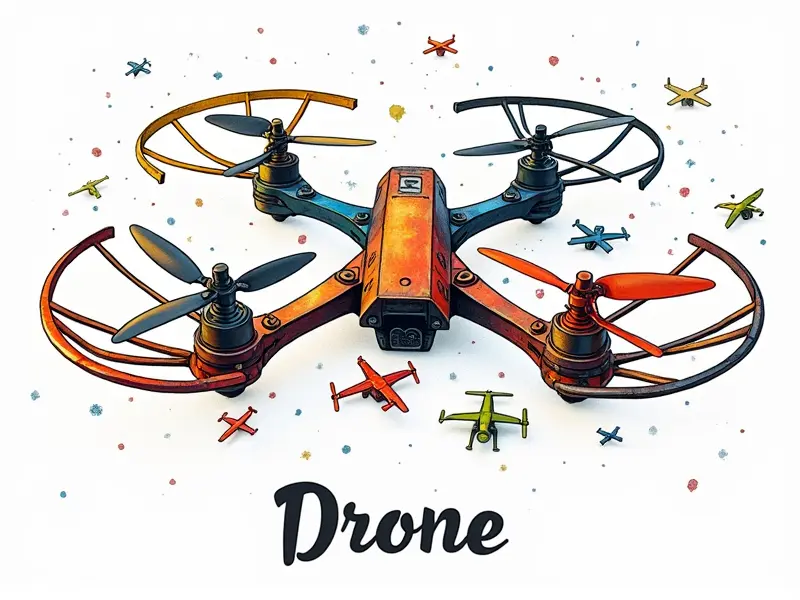How to avoid a drone crash

Top Tips to Prevent Drone Crashes
To avoid a drone crash, start by familiarizing yourself with basic safety practices:
- Pre-flight Checks: Always perform thorough pre-flight checks on your equipment. Ensure all components are securely attached and functioning properly.
- Battery Health: Use high-quality batteries that provide consistent power throughout the flight.
- Weather Conditions: Avoid flying in extreme weather conditions such as strong winds, heavy rain, or fog.
Avoiding RC Quadcopter Mishaps
RC quadcopters are popular for their maneuverability and versatility. However, they require careful handling to prevent crashes:
- Proper Calibration: Calibrate your drone's sensors regularly to ensure accurate flight data.
- Flight Patterns: Practice flying in different patterns and environments to improve your piloting skills.
- Safety Zones: Establish safe zones for testing new maneuvers or learning advanced techniques.
How to Keep Your FPV Drone Flying
FPV racing drones offer an exhilarating experience but require precision and skill:
- First-Person View Setup: Ensure your FPV goggles are properly calibrated for clear, lag-free vision.
- Flight Control: Master the art of flying with a first-person view by practicing in open spaces.
- Safety Gear: Always wear protective gear such as helmets and gloves to prevent injuries during crashes.
Crash Prevention for RC Helicopters
RC helicopters are challenging but rewarding to fly. Here’s how to keep them stable in the air:
- Balancing Act: Maintain proper balance and weight distribution on your helicopter.
- Pilot Training: Take time to learn basic aerobatics and advanced maneuvers through practice sessions.
- Regular Maintenance: Keep your helicopter well-maintained with regular cleaning and part replacements as needed.
Safe Flying: A Guide to Drone Stability
Maintaining stability is key to preventing crashes. Here are some tips for stable drone flight:
- Stabilization Systems: Utilize advanced stabilization systems like GPS and gyroscopes.
- Flying Techniques: Develop smooth flying techniques that minimize sudden movements.
- Environmental Awareness: Stay alert to your surroundings, avoiding obstacles and other aircraft.
Common Mistakes in Drone Piloting
Avoid these common pitfalls to keep your drone safe:
- Lack of Experience: Don’t rush into advanced maneuvers without proper training.
- Neglecting Maintenance: Regular maintenance is crucial for optimal performance and safety.
- Inadequate Battery Management: Over-discharging batteries can lead to sudden power loss mid-flight.
Protect Your Investment: Prevent Crashes
Your drone is a significant investment. Here’s how to protect it from crashes:
- Insurance Coverage: Consider purchasing insurance for your drone to cover repair or replacement costs.
- Spare Parts: Keep spare parts on hand in case of unexpected damage during flights.
- Professional Advice: Seek guidance from experienced pilots and manufacturers for best practices.
Essential Skills for Stable Drone Flight
Mastery of these skills will enhance your drone’s stability:
- Control Precision: Practice fine-tuning control inputs to achieve smooth, precise flight patterns.
- Environmental Adaptation: Learn how to adapt your flying style based on changing environmental conditions.
- Maintenance Routine: Develop a routine for regular maintenance and inspection of your drone’s components.
Never Crash Your FPV Racing Drone Again
FPV racing drones demand precision and quick reflexes. Here are some tips to avoid crashes:
- Practice Makes Perfect: Spend time practicing in safe environments before venturing into competitive races.
- Visual Clarity: Ensure your FPV camera provides clear, uninterrupted views of the flight path.
- Flight Planning: Plan your race routes carefully to avoid obstacles and maximize speed.
Simple Tricks to Keep Helicopters Flying
Helicopter crashes can be devastating. Here are some simple tricks to keep them stable:
- Balanced Weight Distribution: Ensure your helicopter is perfectly balanced before each flight.
- Smooth Takeoffs and Landings: Practice smooth takeoffs and landings to minimize the risk of crashes.
- Regular Servo Checks: Inspect servos regularly for wear and tear, replacing them as needed.
Airplane Drone Safety: Preventing Crashes
Airplane drones require careful handling to prevent crashes. Here’s how to keep them stable in the air:
- Stable Flight Patterns: Develop consistent flight patterns that minimize sudden changes in direction.
- Pilot Training: Take time to learn basic aerobatics and advanced maneuvers through practice sessions.
- Safety Gear: Always wear protective gear such as helmets and gloves to prevent injuries during crashes.
Conclusion
Avoiding drone crashes is essential for both safety and enjoyment. By following the tips outlined in this guide, you can enhance your piloting skills, maintain stability, and protect your investment. Whether you’re flying an RC quadcopter, FPV racing drone, or helicopter, these strategies will help ensure a safe and enjoyable flight experience.

